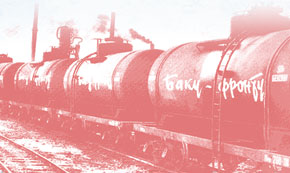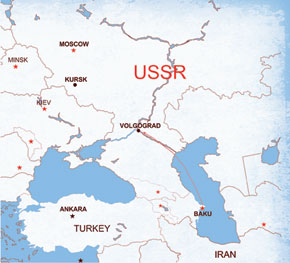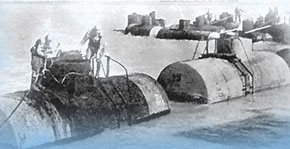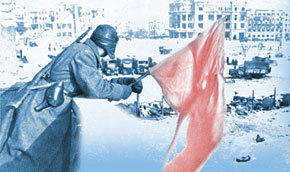Four out of five Soviet aircraft, tanks and trucks used in World War II ran on fuel produced in Baku refineries from oil extracted in the Baku oil fields. From the start of Operation Barbarossa, when German troops invaded the USSR in June 1941, until the end of the war, Azerbaijan produced 75 million tonnes of crude oil, 80% of the union’s petrol, 90% of its naphtha and 96% of its lubricants.
This article considers the significance of Azerbaijani oil in three major battles of World War II: the battles of Moscow, Stalingrad and Kursk.
Fuel supply chaos
At the start of the Great Patriotic War, as it was known in the Soviet Union, there was a good supply of fuel, but no well-defined strategy for its storage and supply to the combat army. In accordance with the mobilization plan, a huge number of fuel tanker wagons were sent to the fronts. At the same time, because of the poor strategy and the retreat of the Soviet troops, the evacuation of fuel from the immediate battle area began. Freight trains met head to head and, as a result, about 8,500 tanker wagons were lined up at railway junctions and in sidings, where they were exposed to enemy air raids and almost totally eliminated. Chaos reigned; in some parts of the front fuel wagons made it through to the battlefields, while in other parts they went to the rear. Fuel supplies went out of control. Nazi pilots bombed important strategic facilities and easily destroyed almost the entire fuel reserve. There was no effective cover, as military laws required, either from air or the ground. Moreover, saboteurs were highly effective. Well-trained and able to cope with the local conditions, they attacked the most vital centres, first of all the ammunition and fuel dumps. The whole frontline was turned into hell, as everything flammable was on fire.
The Soviet Army’s General Staff, Support Services and Fuel Supply Office tried to move quickly to clear the wagons from the railways. Fuel supplies to the north-west were stopped temporarily and the fuel supply procedure was revamped.
Battle of Moscow
Supplying troops in the Battle of Moscow was one of the problems faced by the fuel supply services in autumn and winter 1941-42. In October 1941, State Defence Committee member Alexei Kosygin, who managed the evacuation of factories from Moscow, made a record of all the fuel at oil depots in and around the capital and drew up a successful plan to increase fuel deliveries to the city. Aviation fuel to protect the skies above Moscow was sent from Baku via the Caspian and Volga.
Army General Semyon Kurkotkin, who wrote the substantial The Rear of the Soviet Armed Forces in the Great Patriotic War, believes that the fuel supply system worked properly for the first time during the Battle of Moscow. This contributed considerably to the defeat of the Germans there, their first loss on the Eastern Front.
At the same time, already near Moscow, the Germans started to have problems with fuel.
Battle of Stalingrad
Stalingrad was a prime target for Hitler. It is enough to look at a map of oil deposits and oil pipelines in the east during World War II to imagine the possible development of the war if the city had fallen. In that case the Germans would have controlled the Volga, the main artery of the USSR, and would have cut off the Urals, the location for virtually all the evacuated factories. Oil reserves in the isolated part of the USSR, where the main body of the Red Army was deployed, would have lasted for 10 or 15 days.
On 5 April 1942, Hitler signed Fuehrer Directive No. 41, which said that all forces were to be concentrated on the main operation in the south with the purpose of occupation of the oil-bearing regions of the Caucasus, passage across the Caucasus range and further actions in the southern direction.
So, the choice was made, preparations for the main, crucial battle of World War II began – the Battle of Stalingrad that can rightly be called ‘the Great Battle for Great Oil’! To ensure surprise, the German command concealed the direction of the main strike in the summer campaign. The Wehrmacht created the impression that they were planning an advance in the central part of the front to seize Moscow. As part of a disinformation operation, codenamed Kreml (Kremlin), aerial photographs were taken of Moscow defensive positions, units and command staff were deployed as a diversion, river crossing equipment was delivered and even road signs were produced. As a result, the summer advance of the Wehrmacht in the south came as a big surprise to Stalin.
At 18.00 on 23 August 1942, the Germans committed all the aircraft of the 4th Air Fleet to the bombing of Stalingrad. That dreadful night the city was bombed by 600 aircraft and several tens of thousands of people were killed.
When General Yeryomenko, commander of the South-Eastern Front, asked Stalin to permit the evacuation of the city, the latter replied, If we evacuate the population and mine the facilities, the Germans will think we are abandoning Stalingrad! So the civilian population remained.
The siege of Stalingrad began on 2 September, when Soviet General Chuikov retreated with his 62nd Army into the city. The 64th Army of General Shumilov, which was subordinate to Chuikov, retreated to positions next to its left flank and thus stood face-to-face with the northern flank of the Wehrmacht’s 4th Panzer Army. The siege became a bitter fight to the death, house by house, street by street, with Soviet troops displaying remarkable heroism.
I, as former commander of the 62nd Army, recalled Vasiliy Chuikov, later Marshal of the Soviet Union, declare with all responsibility that Stalingrad could have been taken by the enemy on one condition only: if all the soldiers down to the very last one had been killed. None of the defenders of Stalingrad crossed to the other bank of the river. We had taken an oath: “Stand to the death!”
‘Fire crossing’
German aircraft bombed the city day and night. A glow hung over Stalingrad, as huge oil storage tanks and oil tankers on the Volga burned. A Stalingrad veteran recalled that a solid wall of fire stood over the Volga and the river seemed to be ablaze.
In an attempt to cut off the fuel supply, German aircraft heavily bombed the Kirov oil refinery in Saratov, seriously damaging the facility and temporarily halting its work. Now fuel came only from Baku. The Volga Flotilla supplied both Soviet armies in Stalingrad with foodstuffs, ammunition, fuel and fresh forces ferried across the Volga throughout the entire battle, despite German attempts to paralyse navigation. German aircraft dropped so many mines into the river that the crossing became known as the “fire crossing”. Foodstuffs and ammunition were delivered and the wounded were evacuated under bombs, shells and mine explosions with oil burning on the surface of the water. It was a hellish sight. Despite huge losses of fuel, the flow of oil from Baku did not stop for a single moment.
Flat out
“Our Stalingrad is in every well” was a slogan in the oilfields of Baku! Never in the history of the Azerbaijani oil industry had the resources and the people been so strained as they were during the Battle of Stalingrad – oil workers did not leave the oilfields, nor did refiners leave the refineries.
Four months before the start of the crucial battle, in April 1942, 505,500 tonnes of petroleum products had been transported across the Caspian, with 436,000 of them delivered to Astrakhan. The transportation of such an amount of fuel from the Caucasus to the lower reaches of the Volga and the Kama played the decisive role in supplying the Red Army with fuel when the battles of Mozdok and Stalingrad began.
Overall, 149,000 tonnes of fuel were consumed in the battle for Stalingrad, over 42,000 of them during the counterattack and almost as much, by a modest computation, was eliminated in bombing by the Luftwaffe. But there were sufficient reserves, thanks to Baku oil. When the Soviet counterattack began, they did not experience a lack of fuel, while the Germans actually had neither reserves nor fuel and their armies lost mobility.
Alongside the main priority of supplying Soviet troops with fuel in the battle for Stalingrad, Baku also took care of other fronts. In summer 1942 Baku sailors achieved the near impossible, when for the first time ever they floated railway oil tanker wagons and used tugs to pull them from Baku and Makhachkala east across the Caspian to Krasnovodsk (Turkmenbashi). From there, the Baku oil was transported to the central fronts.
The Caspian was also a transport route for the wounded in the battle for Stalingrad who were brought for treatment to Baku.
Tipping the balance
A turning point was to come in the great battle. The day 22 November became fateful in the history of Nazi Germany. The vanguard of the Soviet troops advanced from two directions and merged at Kalach, putting the German 6th Army into a pocket 30 miles long and 24 miles wide (from north to south). The Germans had no reserves and fuel to continue the military actions.
Tank General Guderian wrote to his wife from the Stalingrad front, Piercing cold, lack of shelter, equipment, heavy losses, the awful situation with fuel supply, all this turns a commander’s duty into a torment.
Field Marshal Manstein pleaded with Hitler by phone to reassign to him the German troops in the Caucasus and switch them to assist the army stuck at Stalingrad. No, the Fuehrer responded, the occupation of Baku is important for us. If we do not get the oil of Baku we will lose the war.
The then chief of the Soviet General Staff, Vasilevsky, recalled in his memoirs that both sides were fairly evenly balanced in terms of troop numbers and hardware at Stalingrad. In November 1943, on the eve of the Soviet counter-offensive, the Red Army had only minor superiority in the number of artillery and tanks. The generals on both sides at Stalingrad were well-matched too. But there was one position, on which Soviet historians and others have remained silent, that tipped the balance in favour of the Soviet troops. That was fuel for aircraft, tanks, troop transports etc.
However, I do not think that fuel was the decisive factor in the Battle of Stalingrad, but it was of great importance. To fail to mention it, as Marshal Vasilevsky and some historians do, means to give an incomplete picture of events and to overlook the contribution of the Baku oil workers, refiners, naval and merchant seamen to the Victory and the Battle of Stalingrad.
Battle of Kursk
The Soviet army once and for all broke the backbone of the German hordes at the Battle of Kursk. More than 6,000 tanks were used in this battle, which was unprecedented in scale. The Soviet fronts at Kursk were led by Marshals Zhukov and Vasilevsky and were made up of over one million troops. More than 19,000 guns and mortars and 2,000 aircraft were used in the battle. When the Germans went into battle at the Kursk salient they had 900,000 soldiers, 10,000 guns and mortars, 2,700 tanks and assault guns and about 2,050 aircraft. The Battle of Kursk lasted 50 days and nights, from 5 July to 23 August 1943.
As they prepared for the Battle of Kursk, the Luftwaffe managed to destroy almost the entire stock of fuel at bases in Saratov and to knock out the cracking plant in the city.
The head of the Oil and Gas Production Department in Azerbaijan, Enver Alikhanov, told me of the impact this had on Baku. One day in early July, at three o'clock in the morning [Azerbaijan Communist Party leader] Mirjafar Baghirov called a meeting of oil workers and oil refiners: “Comrade Stalin just called me and said that the situation with the fuel at the fronts is tough. He is asking us to increase the supply of fuel, especially for tanks.” Voices from the audience began to talk about lack of equipment, refiners, about the possibilities of accidents and so on. Baghirov interrupted everybody firmly: “This is an instruction of Comrade Stalin, and we must do it unquestioningly.” He also added that he expected sabotage attacks on facilities and called for increased vigilance. When we came out of the meeting room, special squads for the protection of facilities were assembled in the reception room.
(Baghirov could not have known exactly where the fuel was needed. Up to 1953, little was known about the battle. It was only with the publication of the book The Battle of Kursk by Ilya Markin that the general Soviet reader learned about the battles of Kursk and Prokhorovka.)
Strained days for the oil refiners became even more demanding: they did not leave their posts. Production was stepped up in all areas: oil refineries operated at the maximum, risking an explosion at any moment. Baku switched to a strict regime of fuel distribution: only for needs of the war.
New methods of processing were developed, in particular, combined refining and re-distillation, which allowed an increase in production of aviation fuel. At the country’s largest refinery, the I.V. Stalin Refinery in Baku, control engineer Mehbali Humbatoghlu Kerimov brilliantly adjusted the settings to obtain aviation fuel by re-distillation. In August alone, the refinery produced a whole train of large tanker wagons of jet fuel in excess of the plan. Thanks to the bold introduction of the new technology, the Baku refiners managed to keep the production of aviation fuel at the pre-war level, despite a fall in the total output of crude oil. They also increased output of high-quality aviation fuel.
As a result, Baku emerged from a difficult situation with credit. During the Battle of Kursk more than 204,000 tonnes of fuel were used, some 90 per cent of which came from Baku.
In 1943, Baku supplied to the front as a whole over 5 million tonnes of oil and oil products with more than 2,000 fuel trains dispatched to the front line. If all these trains were put end to end, they would cover 1,245 km!
At the same time, the Germans had a big problem with fuel in Kursk and had 30-35 per cent less than needed at the start of the offensive.
Victory
That Baku was such a prized target for Hitler is evidence of its value in World War II. Commentators like to speculate that without the Katyusha rocket or the T-34 tank the Soviet Union would not have been victorious against Nazi Germany, but without fuel from Baku the Katyusha rocket launchers could not have been put into position and the T-34s would have remained on the production line.
As Russia’s ambassador to Azerbaijan, Vladimir Dorokhin, said on 7 May 2010, during celebrations to mark the 65th anniversary of the Victory: Without Baku oil, the Soviet victory over fascism would have been impossible.
About the author: Prof. Chapay Sultanov is a doctor of geological and mineral sciences and winner of the State Prize of Azerbaijan. He has researched a range of subjects in Azerbaijani history and is the author of many books and monographs, including Would the Allies Have Won without Baku Oil?, Invasion, The Second Attempt, Oil and Marked by the Devil. The books are available on the website www.sultanov.azeriland.com. At the age of 16, Chapay Sultanov was appointed chairman of the Chess Federation of Azerbaijan.
BIBLIOGRAPHY
Semyon Kurkotkin: Tyl sovetskikh vooruzhennykh sil v Velikoy Otechestvennoy voyne: 1941-45 gg. (The rear of the Soviet Armed Forces in the Great Patriotic War: 1941-45). Moscow, 1977
“Sovershenno sekretno! Tolko dlya komandovaniya!” Strategiya fashistskoy Germanii v voyne protiv SSSR: Dok. I materiali (“Top secret! Only for the high command!” The strategy of fascist Germany in the war against the USSR. Documents and material). Moscow, 1967
Stalingrad: uroki istorii. Svidetelstvuyut uchastniki bitvy na Volge (Stalingrad: Lessons of History. Testimony from participants in the battle on the Volga). Moscow, 1976.
Chapay Sultanov: Would the Allies Have Won Without Baku Oil? Baku, 2008
Alexander Vasilyevskiy: Delo vsey zhizni (The Matter of My Whole Life). Moscow, 1973






